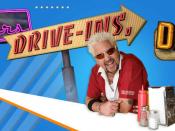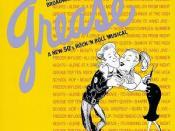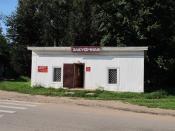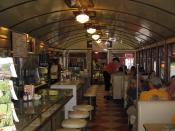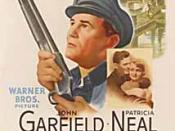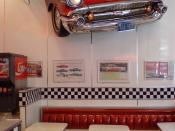The cultural times of the 1950's were a very exciting and changing time in the world of America. After World War II America began to live life with more passion than before. As the times were changing in the 1950's, teenagers started to come into their own. Teenagers started to form their own little world. In the chapter two and seven of "Popular Culture in the Fifties" by Frank A. Salamone, Salamone gives many examples of how teenagers are beginning to come into their own. Salamone uses fads, sex, and hangouts as some ideas to show how teens came into their own in the 1950's.
Teens often define fads. One of the biggest fads for teens in the 1950's was the style of their cloths. " Both guys and gals decided that dressing like mom or dad was square" (Salamone 27). Teens did not want to look like their parents, so they had a different style then there parents.
The girls wore tight dresses and had a beehive hairstyle. Girls who did not want "to reveal too much" (27), were classified as the American ' bobby soxer' style. The 'bobby soxer' style was stiffened petticoats, skirts, and a ponytail. These styles were the basic fad for teenaged girls in the 1950's. The guys also had two styles of dressing. Guys went with the greaser look or the collegiate look. The greaser look featured a black leather jacket, jeans, and a white tee shirt. A classic example of the greaser look is Danny Zuko from the movie "Grease". The guys who went for the collegiate look were very clean cut. They wore white buck shoes and a varsity letter sweater. Teens hated dressing like their parents, it made them feel old. " The clothing defines the age almost as clearly as the styles" (Salamone 98).
" There was far more sex taking place than people realized, and much of it was occurring between teenagers" (Salamone 30). Teenagers in the 1950's were having a lot of sex. Parents were well concerned about their sons and daughters having sex. " In the 1950's parents took special care to discourage their daughters for premature sexual experiences" (Salamone 30). Parents did not want their children to have premature sex; they felt it was nasty, dirty, and dangerous. However parents did realize it had to be discussed more openly then before because these were changing times in the youth of America. If a teenage girl were to become pregnant in the 1950's there were two options. The first was for the two teens to be married immediately. The second was being sent off until they had the baby; they would of course return home with out their child.
Not only did parents discourage pre- marital sex, but they also taught their children that it was wrong to be a homosexual. Teenagers in the 1950's were taught their gender role, and if someone was caught as a homosexual, they were abused both verbally and physically.
Another idea that Salamone uses is the teenage hangout. As a teenager the place to be hanging out was often a diner, drive- in, or a drive- in restaurant. Many teens went to these places with friends or their boyfriend or girlfriend to hangout.
" Teens did have hormones in the fifties. The drive-ins allowed a certain amount of privacy in a public setting" (Salamone 34). Many would go to the drive- in to watch a movie with their lover and start to participate in sexual activities.
Usually after the movies the teens would go to a diner to get something to eat. Just like the movies we see today about the 1950's, diners were a good place to hang out and enjoy a hamburger, fries, and a milkshake. The food was cheap and good. Teens in the 1950's were much less health conscious then teens of today.
Many teens would also go to a drive- in restaurant. They liked to sit in their cars and have soda pop with their friends; sometimes they would go back and forth from their car to the restaurant. The diner, drive- ins, and drive-in restaurants were the biggest hangout places for teenagers in the 1950's; they were like a second home to them.
Salamone uses great ideas to support the idea that in the 1950's teens started to come into their own. He uses many good examples of this. I agree with Salamone on his views. I believe that teens did have their own little world in the 1950's. They had their own fads, they were engaging in sexual activities, and they always hung out at the diner, drive-in movie, or drive- in restaurant. I agree with Salamone and his ideas about teenager in the 1950's. I think he gives a very clear picture of how all different types of teenagers acted in the 1950's. In reading these chapters I read about things that I already knew as well as learning new information about the " Popular Culture in The Fifties".
In conclusion, the 1950's were a big decade for teenagers. Teens lived in their own little world. Much like the ones all teenagers live in no matter what time period they grow up in. The difference between the teens of the 1950's as opposed to other generations is that they really had a big part in changing the face of American teens and how they were looked at. I think teenager of the 1950's showed that they growing but they still had there child hood innocence with them. I think teens of fifties wanted to live their life to the fullest. Unlike the generation before them of the 1940's when so many young men lost there lives in World War II. I think teenagers in the 1950's had a good sense of how fragile life was. They knew how to have within their means and not to take any of it for granted. Teenagers in the 1950's opened up doors for the teenagers of today. I have often asked myself the question if I had one time period to grow up in when would it be? My answer was always the 1950's and this book only validated when I would of liked to grow up.
